Cornish Myths and Legends
Cornwall’s distinct identity and cultural richness can be traced back to its geographic and historical isolation from the rest of England, as well as its close ties with other Celtic regions like Wales, Ireland, and Brittany.
The Celtic heritage of Cornwall is especially evident in its myths, which often carry elements of ancient paganism. These myths, many of which feature deities, spirits, and supernatural beings, have been preserved and passed down through the centuries, particularly in Cornwall’s rural areas. Cornwall’s separation from the dominant religious movements in England allowed these older traditions to survive longer, even as Christianity took hold in the wider British Isles. The lack of the same level of religious oversight and interference that characterized much of England meant that Cornwall remained a a refuge for the preservation of folk traditions and legends, unimpeded by the strictures of the Church, which continued to inspire throughout the centuries.

St Nectan’s Glen
Piskies, giants, mermaids and ghostly tales
Cornwall is a Duchy with a rich heritage of tales and superstitions, often celebrated and kept alive today by the ‘droll tellers’ or storytellers seen at festivals, and used in plays.
Reputedly Cornwall is the land which was inhabited by giants who shared it with the ‘little people’ – or pixies/piskies and fairies. This is where Cornish myths and legends such as King Arthur and his court, and Jack the Giant Killer originated.
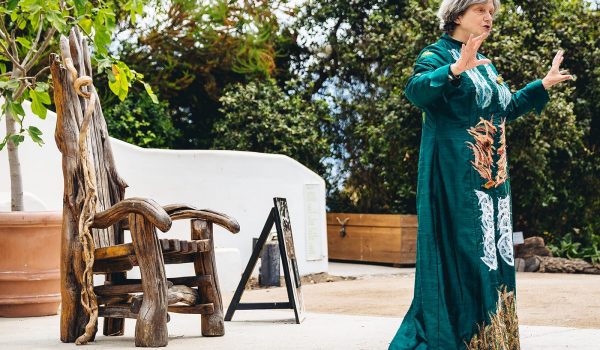
Storyteller at the Eden Project
Pobel Vean or ‘the little people’
It is also unsurprising that being surrounded by sea and with many coves and hidden inlets – in an economy bolstered by piracy and reliant on fishing – that there are many tales of the sea including enchanting mermaids and ghostly galleons.
Cornwall’s other livelihood, tin mining, also gave rise to its fair share of superstitions.
Piskies
Said to inhabit stone circles, barrows and ancient dolmans, these childlike and mischievous little creatures appear in many Cornish tales.
Known for dancing and playfulness, their leader was Joan the Wad.
Not to be confused with ‘spriggans,’ (or ‘isspriggan in West Penwith) who have a dangerously evil edge to their personality.
Bucca/Bucka
Bucca Gwidden/Widn are the good version and Bucca Dhu/Boo is the bad. Reputed to live in tin mines and around the coast. Similar legends appear in Irish and Welsh culture.
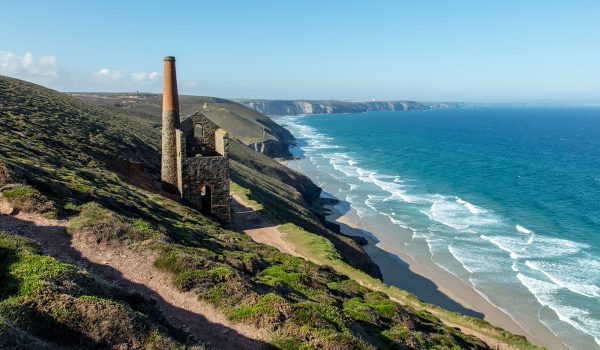
Wheal Coates
Knockers
Variously thought of as helpful or malevolent, they’re supposed to knock on the walls of tin mines to warn of, or trap miners in, an impending mine collapse.
Some believe they are spirits of miners lost in accidents, others that they are little creatures who play practical jokes on miners.
Possibly an amusing invention of oxygen-starved miners, they would leave bits of pasty to keep them happy.
Cornish places associated with ‘little people’
- Trevose Head – where Omfra, a piskie, lost his laugh
- Bodmin Moor – Dozmary Pool – where Omfra the piskie regained his laugh with the help of King Arthur disguised as a chough
- Boscastle – Museum of Witchcraft
- Padstow – Nellie Sloggett, folklorist, published many stories under the name Enys Tregarthen
- Newlyn, Mousehole – it is tradition for fishermen to leave out a portion of their catch for the Bucka
- Penzance – where Bucca can apparently be heard calling from the sea
- Land’s End – legends of Bucca’s inhabiting the cliffs
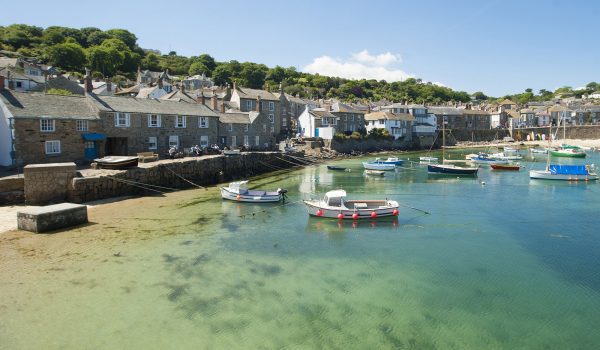
Mousehole Harbour
Giants
Corineus
Mentioned in King Lear as the founder of Cornwall. He lived at St Michael’s Mount and is said to have defeated Gogmagog, another giant.
Blunderbore
Appearing in many Cornish and English stories, he supposedly caused havoc for travellers to St Ives, along with his brother Rebecks.
Cormoron
A giant purported to have lived in the forests now underwater at Mounts Bay. Boulders littering the landscape surrounding the area are said to have been thrown by him in fights with another giant. He made his wife, Cormelian, carry heavy stones in her apron pockets to build St Michael’s Mount. When he was sleeping she cheated and carried a lighter green stone instead and incurred his wrath when he awoke. The green stones seen in the area today are said to have been deposited when he kicked her and her apron strings broke.
Bolster
This is the story of the giant who fell in love with the missionary St Agnes, but he was already married and wanting to be rid of him, she challenged him to fill a hole in the ground at Chapel Porth with his blood. He happily agreed as he was so large that he could stand with one foot in Carn Brea and the other at St Agnes Beacon. Not realising the hole she had chosen led out to sea, he opened a vein and bled to death. Today a red stain in the rock there is said to be his deathbed.
Ralph the Wrath
The giant who enjoyed throwing the boulders from the surrounding landscape and stealing loot from passing sailors and hiding it in his cave at Portreath.
The Kind Giant of Carn Galver
A rare, kind giant who protected the villagers from being attacked by other giants. He is said to have built the logan, or rocking stone, at Zennor to send himself to sleep.
Areas where the Cornish giants are said to have lived
- St Michael’s Mount – also credited with where Corineus defeated Gogmagog
- St Michael’s Mount – Cormoron’s home
- Trencrom Hill – where giants such as Cormoron threw rocks at each other
- Carn Galver – a kinder protective giant watched over the inhabitants of Zennor and Morvah
- St Agnes – Where the giant Bolster fell in love with St Agnes
- Penwith – Blunderbore lived at Ludgvan
- Portreath – Ralph the Wrath
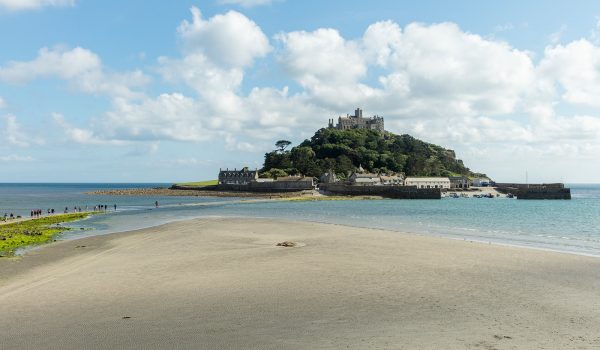
St Michael’s Mount
Cornish mermaids and the tales of the sea
There are many stories of mermaids bringing bad omens to communities in Cornwall.
A whole village between Looe and Seaton was supposedly turned to sand by a mermaid’s curse.
Here are some of the most famous Cornish mermaid tales:
The Mermaid of Padstow or The Doom Bar Mermaid
In one of several versions of the tale, the mermaid enjoyed sitting on a rock at Hawker’s Cove. Falling in love with a local man, she tried to lure him to her watery home and he shot her to escape. In another version, he fell in love with her and when rebuffed, he shot her. A third version explains how a local fisherman mistook her for a seal and shot her. The tale, however, always ends up with the mermaid being shot and with her dying breath, she cursed the harbor to be treacherous to sailors. Since then, many ships have wrecked on the Doom Bar, a sandbank at the mouth of the Camel Estuary.
The Mermaid of Zennor
The Churches at Zennor and Morvah were said to have had a beautiful lady visitor with the sweetest singing voice. Nobody knew of her origins or where she lived, plus she was seen infrequently over many years, but never seemed to age. After a good many years, she fell in love with a man who was the best singer in church, Mathey Trewells. After following her home one day, neither were ever seen again. Further to this, a ship was out to sea off Pendour Cove and wished to drop its anchor. Upon doing so, a mermaid appeared and asked if the anchor could be moved as it was resting on the door to her home and she was unable to get to her children. Believing the children to be those of the mermaid and Mathey Trewells, the ship fled.
The Mermaid of Lamorna
According to folklore, a fisherman or sailor (sometimes named Matthew Trewhella) was enchanted by a hauntingly beautiful song that echoed across the cove. He followed the melody and discovered a stunning woman with an otherworldly aura. Unbeknownst to him, she was a mermaid. The two fell in love, and he disappeared into the sea, never to be seen again.
Some versions say he willingly joined her underwater kingdom, while others suggest a storm or a curse kept him from returning to land. Locals claimed that on calm nights, the same eerie song could still be heard over the waves.
To see her foretells a storm, but if you do hear her sing, it supposedly spells certain peril, for a shipwreck will occur in exactly seven days.
The Mermaid of Kynance Cove
Less well-known but still captivating, this legend tells of a mermaid who would sing to sailors near Kynance Cove. Some say she fell in love with a fisherman, while others claim she only sought to lure sailors to their doom. This tale, like many others, emphasizes the dangerous allure of mermaids.
In a different telling, the mermaid of Kynance Cove is not a siren seeking to lure men to their doom but a guardian spirit of the sea. One night, she appeared to a group of fishermen who were about to set sail despite an ominous sky. She warned them of an approaching storm and urged them to stay on land. Some heeded her warning, while others dismissed it as superstition. Those who ignored her vanished in the storm that struck that very night.
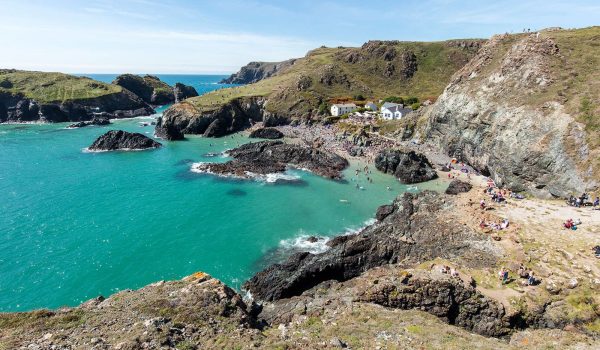
Kynance Cove
Whooper of Sennen Cove
According to local folklore, an eerie, unearthly wailing could sometimes be heard along the shore of Sennen Cove, a small fishing village near Land’s End. The mysterious cries, described as a mournful “whooping” sound, were said to foretell an impending storm or disaster at sea.
Some believe the Whooper was the restless spirit of a drowned sailor, forever warning others of the dangers of the treacherous waters. Others suggest it was the voice of a lost soul, cursed to wander the cove for eternity.
While skeptics attribute the sounds to the howling wind or the crashing waves, the legend of the Whooper remains a chilling part of Cornwall’s rich maritime folklore—one that still lingers in the minds of those who walk the shores on stormy nights.
Strange Lights
The tale of Strange Lights in Cornwall takes on a particularly eerie twist when tied to the events surrounding World War I. According to this version of the legend, the mysterious lights seen out to sea during the latter part of the war were believed to be the ghostly manifestation of a Cornish fisherman who had been tragically drowned by a German submarine.
The story goes that this fisherman, whose name is often lost to time, was one of many who met a grim fate when a German U-boat sank his vessel in the waters off the Cornish coast. His body was never recovered, and, as the legend suggests, his spirit became restless, haunting the very sea that had claimed his life.
As the lights were first reported in the years following his death, many locals came to believe the glowing orbs were his spectral presence, wandering the waves. It was said that the lights had a strange, almost hypnotic quality, drawing vessels towards them, particularly those from enemy forces.
The more supernatural part of the story claims that the lights were a form of vengeance, designed to lead German warships to their doom. Some believed the fisherman’s ghost took it upon himself to protect Cornwall from enemy forces in a final act of defiance, ensuring that any German warships approaching would meet the same fate he did.
This eerie tale continued to be shared in the years following the war, with many fishermen and locals claiming to have seen the lights over the sea, particularly during dark, foggy nights. While there’s no concrete evidence to confirm the lights’ supernatural nature, they remain one of Cornwall’s most intriguing wartime legends, blurring the lines between history, folklore, and ghostly encounters.
Mysterious Ship of Porthcurno
The legend centers around an old ship, which was said to have been seen sailing in and out of the bay under strange, unexplained circumstances.
According to the story, the ship would appear on misty evenings, seemingly appearing out of nowhere, its sails billowing in the wind, but there were never any visible crew members aboard. The ship would sail close to the cliffs and then vanish as quickly as it came, leaving the local fishermen and villagers mystified.
Some versions of the legend claim the ship was a ghostly vessel, perhaps the spirit of a ship that had been lost at sea long ago. Others believe it to be a cursed vessel, doomed to wander the waters of Porthcurno forever. Some locals even whisper that the ship might be a warning—of approaching danger.
Despite numerous reports of sightings over the years, no one has ever been able to explain the phenomenon definitively, and the ship’s ghostly appearances remain one of Cornwall’s most enduring maritime mysteries.

Porthcurno
Lyonesse
A fisherman’s legend tells of Lyonesse, a lost land that once stretched between the Isles of Scilly and the western coast of Cornwall. According to the tale, an entire town was swallowed by the sea, leaving nothing behind but the distant toll of its church bells, heard faintly over the waves.
Only one man is said to have escaped the catastrophe—away on a hunting trip at Land’s End, he returned to find his home vanished beneath the water. His white horse, in its frantic flight, lost a shoe along the way. Today, the emblem of three horseshoes and a white horse appears on the crests of local families who claim descent from the lone survivor.
Some believe the town’s demise was divine punishment for an unspoken sin, while others suggest a more natural cause—a cataclysmic tsunami or rising sea levels may have doomed Lyonesse to its watery grave.
Places associated with Mermaids and tales of the sea
- Padstow – Doom Bar – Hawkers Cove – The Mermaid of Padstow
- Sennen Cove – Whooper legend
- Penzance to Porthcurno – ghostly galleon ship
- Land’s End to the Scilly Isles – the lost town of Lyonesse
- Lizard Peninsula – The Mermaid of Kynance Cove
- Zennor – St Senara’s Church and Morvah – The Mermaid of Zennor, a carved bench with a mermaid motif is at St Senara’s Church, allegedly the bench where the mermaid entranced Mathey Trewells.
- Lamorna – Mermaids Rock
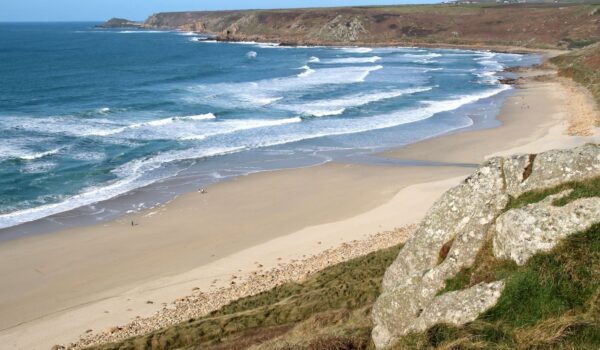
Sennen Cove
Legendary tales
Cornish tales of King Arthur abound, with many related tales having a three-way love affair as a central theme, plus plenty of magical elements.
King Arthur
The most famous of tales associated with Cornwall. Was Arthur a true British Warrior and founder of Britain, or a mythical and fairytale hero? Arthurian legends appear many times in different areas of Britain, but his conception is said to have taken place at Tintagel Castle, on the north Cornish coast. His father, Uther Pendragon, is purported to have acquired the help of the wizard Merlin, in order to disguise himself as the Duke of Cornwall and entice the Duke’s wife, Ygerna, into becoming Arthur’s mother.
Further Arthurian legends such as that of ‘Excalibur’ and ‘the Lady of the Lake’ allegedly took place at Dozmary Pool on Bodmin Moor.
Mark of Cornwall & the tale of Tristan and Iseult
Related to Arthurian legends, this is the tale of the 6th-century warrior and King of Cornwall, Mark, ‘the hound of the sea.’ Also named Conomor, the King ruled from Tintagel Castle. The tale pre-dates that of Uther Pendragon and Ygerna but has a similar echo.
King Mark, wanting a bride, sends his nephew (or son in some tales) Tristan, to fetch the beautiful Irish maiden, Iseult. On the homeward journey Tristan and Iseult, by misadventure, drink the love potion prepared by the queen for her daughter and King Mark.
Jack the Giant Killer
Incorporating many defeats of fearsome Cornish giants, Jack is a clever farm boy chosen to accompany Arthur’s son on missions and later admitted to the round circle for his continued servitude. Ridding the land of many of its terrible giants, Jack gains various magical items to help his efforts.
The Legend of Tom Bawcock
A hero at Mousehole who risked his life to bring back fish to the starving townsfolk during a storm. On his return, a big pie called a Stargazy Pie was made to feed all the townsfolk.
Cornish places associated with legendary tales
- Tintagel – conception place of King Arthur
- Tintagel – King Mark of Cornwall/Conomor ruled from the castle
- Fowey – Castle Dore – Tristan Stone – where King Mark’s nephew/son buried
- Dozmary Pool – place of the Arthurian Excalibur legend
- Mousehole – Tom Bawcock and Stargazy Pie
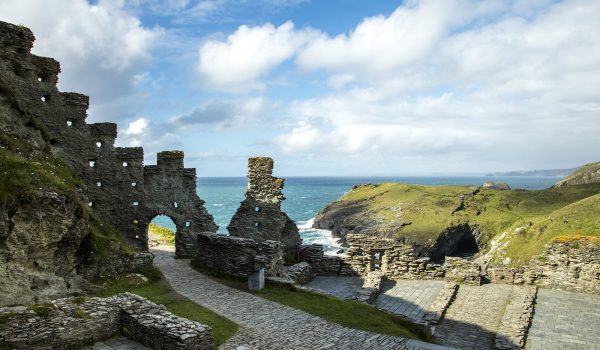
Tintagel Ruins
Ghostly Cornish tales
Jan Tregeagle
The ghost of this 17th century magistrate and lawyer, who had a living reputation for his evil and ruthless acts, attribute Jan Tregeagle as being one of the most hair-raising hauntings in Cornwall. Legends have him committing many felons, including that of murdering his wife. In cahoots with the devil, he appeared to testify at a court case held after his death. Fearing they were unable to send him back to hell, the court ordered him to complete pointless tasks until judgement day. Removing all the water from Dozmary Pool with a perforated limpet shell, he escaped from his first task to Roche Rock. Then given the task of weaving rope from sand at Gwenor Cove, two versions of the story have him completing the task when the water froze on a cold night or his efforts being destroyed by a storm. Either way, St Petroc had to be summoned to bind him in chains and take him to Helston.
Ghostly Church Bells
A series of ghostly bells reputedly have been heard tolling at midnight from a graveyard at Land’s End. Said to be from the spirit of a sea captain who refuses to acknowledge his ship has sunk. It’s considered a bad omen to hear them if you are a sailor, as after one unlucky sailor reported hearing them, he too was lost at sea.
Areas associated with ghostly tales
- Bodmin Moor – the Beast of Bodmin’s territory
- Dozmary Pool – Where Jan Tregeagle had to remove water from the pool with a limpet shell
- Sennen – Gwenor Cove – Where Jan Tregeagle had to weave sand to rope
- St Austell – Roche Rock – Where Jan Tregeagle escaped to from the task at Dozmary Pool
- Wadebridge – St Breock Church – where Jan Tregeagle is allegedly buried
Other tales and superstitions
There are lots of other Cornish tales and superstitions, with many more centred around Cornish saints.
However here are a few that you might like to know whilst visiting the area:
Fishermen’s Superstitions
St Ives’ fishermen would not forgive you if you whistled at night, and Cornish fishermen will only count their catches using an old chant in the Cornish language.
White Hares
In Cornwall, these are the spirits of girls who have died of a broken heart.
Tin Miners Superstitions
A miner meeting a snail on his way to work would feed it some of their dinner or a little tallow from their lanthorns to avoid a bad omen. The word cat or the presence of one near a mine will also stop miners from their work until it has been caught and killed. It’s also unlucky to whistle down a tin mine – it might annoy the knockers, as they had an intense dislike of the sound!
The Merry Maidens
Stone circle of 19 stones where nineteen maidens were turned to stone for dancing on the Sabbath. The two male pipers who were accompanying them realised the clock was about to turn midnight and scurried away up the hill, only to be turned to stone there. There are 2 more standing stones further up the hill.
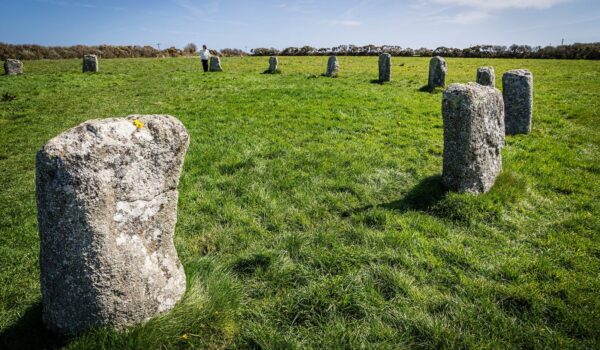
Merry Maidens
The Logan Stone
A naturally balancing stone which rocks in the wind is a Logan stone. At Nancledra there was a Logan stone, it was known as the 12 O’Clock Stone and only rocked at midnight. Said to be the meeting place of witches, new converts would approach the stone in secret and touch it nine times at midnight. Also said to cure local children of rickets if laid on the stone and rocked. However, this only worked if they were born in wedlock!

The Logan Stone
The Devils’ Stone
Helston’s name has been attributed to when the devil was carrying a large stone through the sky to block the gates of hell. Confronted by St Michael, he dropped the stone on the area.
St Non – Altarnun Well
There is a well dedicated in honour of St. Non (also known as Nonna or Nonnita), who is said to have been the daughter of an Earl of Cornwall, and mother of St David, whose waters were supposed to have the power of curing madness/lunacy.




